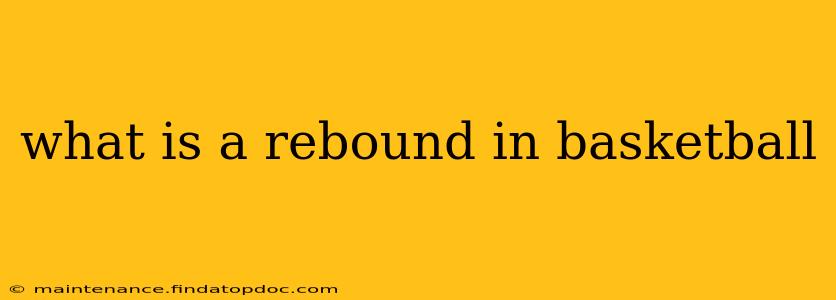In basketball, a rebound is the act of securing the ball after a missed shot. It's a crucial aspect of the game, influencing possession, scoring opportunities, and overall team success. This guide delves into the intricacies of rebounds, explaining different types, strategies, and their importance in the sport.
What are the Different Types of Rebounds?
There are two main types of rebounds:
-
Offensive Rebounds: These occur when a team retrieves the ball after their own missed shot. Securing an offensive rebound gives the team a second chance to score, often leading to high-percentage shots near the basket. Offensive rebounding is a key element of strong inside scoring teams.
-
Defensive Rebounds: These are rebounds grabbed by a team after their opponent's missed shot. A strong defensive rebound secures possession and prevents the opposing team from getting another scoring opportunity. Effective defensive rebounding is a foundation of a strong defensive strategy.
How Important are Rebounds in Basketball?
Rebounds play a vital role in basketball's overall flow and outcome. Teams that dominate the boards often control the tempo and have more opportunities to score. Here’s why rebounds are so important:
-
Second-Chance Points: Offensive rebounds directly lead to second-chance scoring opportunities. Teams that excel at offensive rebounding can significantly increase their points per game.
-
Possession Control: Securing defensive rebounds prevents the opponent from scoring and keeps possession with your team. This leads to more offensive possessions and a higher chance of victory.
-
Transition Opportunities: Quickly securing a defensive rebound can initiate a fast break, allowing your team to exploit the opponent's defense before it sets up.
-
Game Momentum: Dominating the boards, both offensively and defensively, can significantly shift game momentum. A strong rebounding performance can demoralize the opposing team and boost the confidence of your team.
What are the Techniques for Effective Rebounding?
Effective rebounding involves more than just jumping high. Several techniques contribute to success:
-
Positioning: Getting into a good position is crucial. Players need to box out their opponents (using their body to prevent them from getting to the ball) and anticipate where the ball will land.
-
Timing: Jumping too early or too late can lead to missed rebounds. Timing your jump to coincide with the ball's descent is essential.
-
Technique: Using both hands to secure the ball and bringing it down quickly helps prevent the ball from being stripped away.
-
Strength and Athleticism: While technique is key, physical strength and athleticism also play a significant role in successful rebounding.
How Can I Improve My Rebounding Skills?
Improving your rebounding skills takes practice and dedication. Here are some tips:
-
Practice Boxing Out: Regularly practice boxing out drills to improve your ability to position yourself for rebounds.
-
Work on Jumping Technique: Focus on improving your vertical jump and your ability to time your jumps effectively.
-
Develop Strength and Agility: Include strength training and agility drills in your workouts to increase your physical capacity for rebounding.
-
Game Experience: The more you play, the better you'll become at reading the game and anticipating where the ball will land.
What are some common rebounding strategies?
Teams employ different strategies depending on their style of play and the opponent. Common strategies include:
- Double-teaming the post: Sending two players to box out and rebound in the post.
- Crashing the boards: Having multiple players aggressively pursue the rebound.
- Strategic rebounding assignments: Assigning specific players to focus on offensive or defensive rebounding.
What is the difference between a rebound and a tip-in?
A tip-in is a specific type of shot taken immediately after gaining possession of a rebound, typically near the basket. A rebound is the act of securing the ball, while a tip-in is a subsequent shot attempt.
By understanding the different types of rebounds, their importance, and the techniques involved, you can better appreciate their critical role in basketball. Mastering rebounding is essential for both individual and team success.
